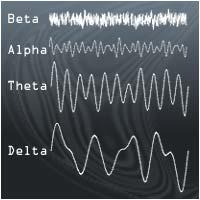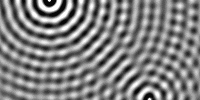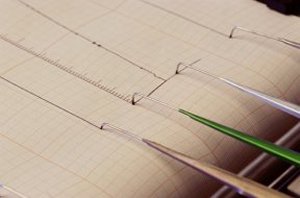 |
Brainwaves Your brain is made up of billions of brain cells called neurons, which use electricity to communicate with each other. The combination of millions of neurons sending signals at once produces an enormous amount of electrical activity in the brain, which can be detected using sensitive medical equipment (such as an EEG), measuring electricity levels over areas of the scalp. The combination of electrical activity of the brain is commonly called a Brainwave pattern, because of its cyclic, 'wave-like' nature. Our mind regulates its activities by means of electric waves which are registered in the brain, emiting tiny electrochemical impulses of varied frequencies, which can be registered by an electroencephalogram. These brainwaves are known as: |
|
 |
|
Beta
emited when we are consciously alert, or we feel
agitated, tense, afraid, with frequencies ranging from 13 to 60 pulses
per second in the Hertz scale. |
|
|
|
Alpha
when we are in a state of physical and mental relaxation,
although aware of what is happening around us, its frequency are around
7 to 13 pulses per second. |
 |
|
Theta
more or less 4 to 7 pulses, it is a state of somnolence
with reduced consciousness. |
|
|
|
Delta
when there is unconsciousness, deep sleep or catalepsy,
emitting between 0.1 and 4 cycles per second. |
 |
|
In general, we are accostumed to using the beta brain rythm. When we diminish
the brain rythm to alpha, we put ourselves in the ideal condition to learn
new information, keep fact, data, perform elaborate tasks, learn languages,
analyse complex situations. Meditation, relaxation exercises, and activities
that enable the sense of calm, also enable this alpha state. According
to neuroscientists, analysing electroencephalograms of people submmited
to tests in order to research the effect of decreasing the brain rythm,
the attentive relaxation or the deep relaxation, produce signficant increases
in the levels of beta-endorphin, noroepinephrine and dopamine, linked
to feelings of enlarged mental clarity and formation of rememberances,
and that this effect lasts for hours and even days. It is an ideal state
for synthetic thought and creativity, the proper functions of the right
hemisphere. As it is easy for the hemisphere to create images, to visualise,
to make associations, to deal with drawings, diagrams and emotions, as
well as the use of good-humour and pleasure, learning is better absorbed
if these elements are added to the study methods. || Museums of the Mind || |